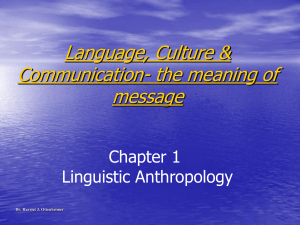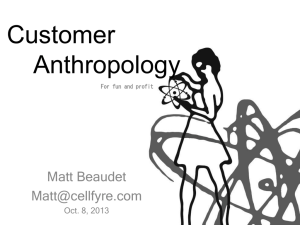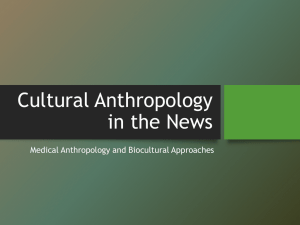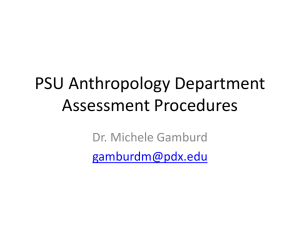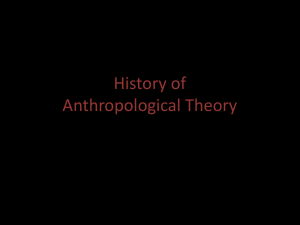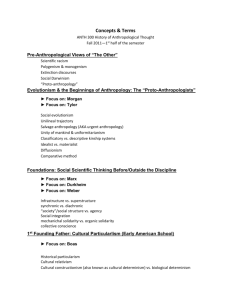Anthropology, BA/BS - University of Alaska Anchorage
advertisement
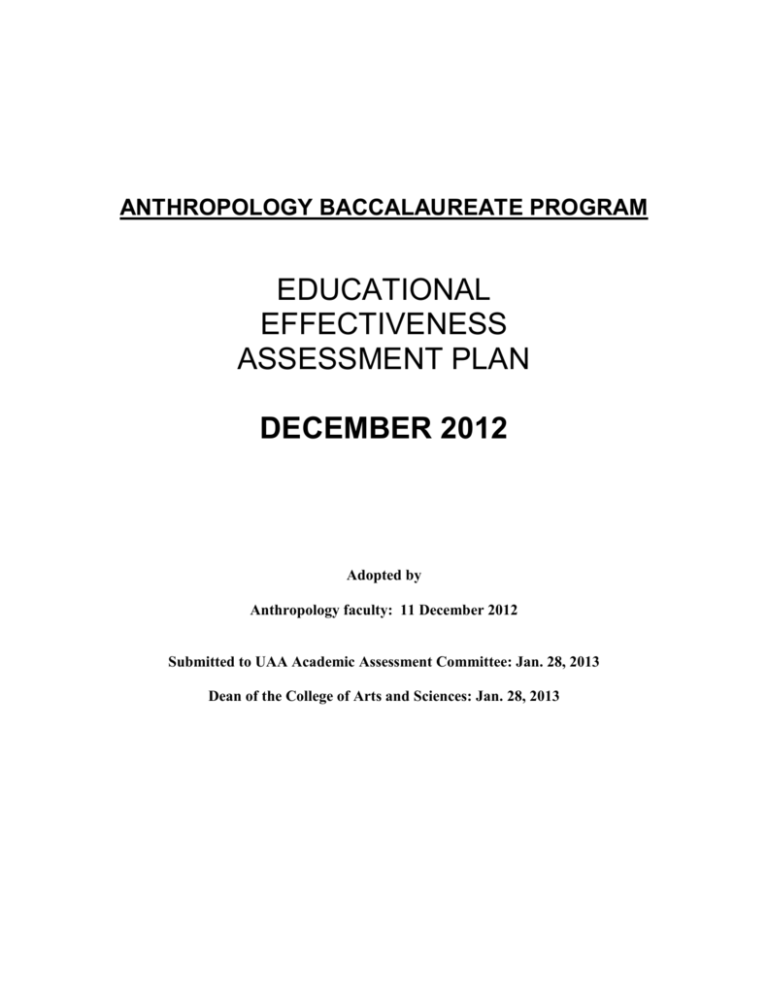
ANTHROPOLOGY BACCALAUREATE PROGRAM EDUCATIONAL EFFECTIVENESS ASSESSMENT PLAN DECEMBER 2012 Adopted by Anthropology faculty: 11 December 2012 Submitted to UAA Academic Assessment Committee: Jan. 28, 2013 Dean of the College of Arts and Sciences: Jan. 28, 2013 TABLE OF CONTENTS Introduction 1 Anthropology Department Mission Statement 1 Program Summary 2 Student Learning Outcomes (2009) 3 Revised Student Learning Outcomes (2012) 3 Revisions to Assessment Measures 4 Outcome 1 4 Outcome 2 6 Outcome 3 7 Outcome 4 9 Assessment Implementation 10 Formulation of Recommendations for Program Improvement 10 Modification of the Assessment Plan 10 ii Introduction This document outlines a plan for the assessment of student learning outcomes for the Anthropology Baccalaureate program. Assessment strategies for the BA/BS were developed in 2005 at a department retreat and were revisited at a department retreat in August 2011. The August 2011 retreat initiated the drafting of a department mission statement, and prompted a reconsideration of BA/BS program outcomes. The modifications shown in this document represent a broadening of outcomes, with the intent of recognizing that a wider pool of course offerings fundamentally contribute to the skill set imparted to students during the course of the anthropology major. This revision of the department’s assessment plan is scheduled for implementation in spring 2013. The plan also remains provisional because department faculty are discussing possibilities for streamlining anthropology undergraduate course offerings. As an interim document, then, we have chosen to meter undergraduate progress using courses identified in the earlier assessment along with select additions. We anticipate in the short term that subsequent assessment revisions will concern the courses selected for assessment more than revisions to outcomes. Anthropology Department Mission Statement Anthropology is a discipline that employs multiple perspectives to provide students with understandings about the diversity of the human experience across space and time. Culture, the learned and created aspects of human behavior, is a key concept used in anthropology and provides students with insight into how human societies differ in perspectives and values. Anthropologists seek not only to define how people organize their lives and fashion meaning from the world, but also to understand how and why cultures and populations change. In anthropology courses, students will acquire understandings about human societies at various times and places using a variety of scientific and theoretical approaches including the evolution of the human species, the nature of language, the construction of meaning, and the daily practices of cultural activity which organize their lives. Anthropology’s cross-cultural approach provides important tools with which students can gain insight into differences and similarities exhibited by societies as well as the processes engendering conflicts and transformation in an increasingly interdependent world. The Anthropology Department at UAA offers undergraduate and graduate degrees, as well as a minor in anthropology. The undergraduate degree (available as either a BA or BS) offers classes in all four subfields of the discipline: cultural anthropology, physical anthropology, archaeology, and linguistic anthropology. The graduate program offers MA degrees in general anthropology and in applied anthropology, which employs anthropological perspectives and research methods to identify, analyze, and aid the resolution of contemporary social issues and problems. Anthropology faculty members practice engagement in teaching, research and service to produce knowledge that is relevant to the concerns of local, national and international communities. Faculty members are committed to collaborative research and work with local, national and 1 international organizations—both governmental and nongovernmental –and, in particular Alaska Native communities, in both research and community service. Anthropology courses and training address key core themes of the UAA campus in understanding one’s own culture, acquiring informed critical awareness and understanding of cultural differences, similarities and ambiguities, and providing the basis for respecting and celebrating diversity in a variety of forms. Program Summary As outlined in the mission statement, the overall goal of the BA/BS in Anthropology program is to provide graduates with a liberal arts education in general and an understanding of the methods and theories of the four fields of anthropology. This provides our students with the skills they need for employment after graduation and a solid foundation in the discipline should the student go on to graduate school. Anthropology majors are required to take at least three of four lower division courses on anthropological subfields (cultural anthropology, archaeology, biological anthropology, and linguistic anthropology). Students also take ANTH A250: Rise of Civilization and ANTH A410 History of Anthropology. Remaining degree requirements enable students to choose specific skill sets and themes. All majors choose three “area courses,” two “theoretical/methodological courses,” and take two anthropological electives from any of these categories. The structure of the anthropology major ensures that all degree seekers learn essential facets of the discipline—specifically, 1) foundational knowledge in at least three anthropological subfields, 2) fundamentals in human evolution and historical cultural change (A250), 3) an understanding of cultural diversity, 4) what constitutes an anthropological approach to a topic, and 5) a critical reflection upon anthropological practice (A410). The degree structure allows students to acquire these skills through a range of offerings that reflect anthropology’s wide topical and thematic reach. This is an approach we feel is fruitful to student’s overall development and engagement with the discipline. From an assessment standpoint, the department has emphasized the evaluation of anthropology majors because it is this group that is exposed to the greatest range of student learning outcomes. This said, there is presently only a limited set of courses for evaluating cohorts at different stages of the degree process. 1 ANTH A250 is a university requirement for all BA/BS degree seekers, but may be taken at any point in the degree process. ANTH A354 Culture and Ecology is a popular course for anthropology majors (since it serves also as a capstone), but is not marked as a degree requirement. Only in ANTH A410 are we assured of assessing all anthropology majors. All other upper division courses are taught in a two- or three-year rotation that limits their applicability as measures for annual assessment. Some of these circumstances may change with a refining of course offerings (refer Assessment Implementation section). 1 A contributing factor is that UAA establishes no deadline for declaring majors. The UAA Catalog does not list any such provisions, and responses from the Advising and Testing Center and the Office of Degree Services (both contacted December 5, 2012) indicate that indeed no deadline presently exists. This situation does place some limitations on the ability for departments to track majors over the course of the degree. 2 In sum, the Anthropology department’s student learning outcomes have placed particular emphasis upon student performance in ANTH A410, since this is the only upper division course specifically required of all majors and is taught every year. The student learning outcomes identified in the 2009 assessment report are as follows: Student Learning Outcomes (2009) At the completion of this program, students are expected: 1. To understand the development of anthropological theory 2. To know the major theorists in the field and place them in their historical contexts 3. To be able to critically evaluate the development and history of anthropological theory 4. To acquire a basic understanding of human evolution and associated genetic and adaptive processes A comparison between this set of outcomes and the department’s mission statement indicates a need to gauge student attainment across a wider range of facets. In November 2012, the department approved the following revisions: Revised Student Learning Outcomes (2012) The anthropology department seeks to provide educational outcomes for students derived from program and course objectives associated with the BA and BS degrees so that graduates will be able to: 1. Explain current understandings about human beings and behavior including the evolution of humans, the nature of culture and cultural processes, the features of language and characteristics of linguistic use, the forms of biological diversity and the significant trajectories of change which have led to the current status of humanity. 2. Demonstrate an understanding of different scientific and theoretical approaches in anthropology, their epistemological and conceptual foundations, their strengths and limitations, and the types of topics, issues and problems they are designed to address. 3. Apply liberal educational skills, such as independent knowledge acquisition, problem identification, critical thinking, formation and evaluation of hypotheses, and organized and effective presentation of information, to anthropological materials demonstrated through various types of presentation including scientific and technical writing, effective public speaking and electronic media presentation. 4. Demonstrate ability to apply anthropological concepts and perspectives to understanding local social and cultural practices occurring outside the classroom in the community. 3 Revisions to Assessment Measures This section identifies assessment measures appropriate to the revised student learning outcomes. Each learning outcome is here parsed into constituent elements to aid selecting courses for program assessment. Assessment measures draw as much as possible from forms of assessment already implemented in courses. This recognizes that a deliberate connection exists between course student learning outcomes and course assessments, as well as between course student learning outcomes and the department’s mission statement. A second benefit is that it ensures annual assessments can be conducted in an efficient manner. OUTCOME 1 Outcome 1 Explain current understandings about human beings and behavior including the evolution of humans, the nature of culture and cultural processes, the features of language and characteristics of linguistic use, the forms of biological diversity and the significant trajectories of change which have led to the current status of humanity. This outcome can be divided into three essential elements concerning a) evolution and biological diversity, b) the nature of culture and culture processes (including language), and c) the understanding of trajectories of cultural change. While our department teaches specialized courses on these subjects that students may take as electives, course curriculum guides for several lower division courses ensure that anthropology majors learn the following fundamentals. a) Evolution. Knowledge of the basic principles on which evolution is based, and a familiarity with its terminology Knowledge of the time depth over which human evolution has taken place, including when “fully modern humans” arrived on the scene and when culture becomes identifiable. Knowledge of culture as a learned, adaptive institution, and examples of how this has fed back onto pathways of human evolution and cultural complexity. Moreover, students should be able to outline relations of culture and behavior: to specify differences between cultural diversity and biological diversity. b) Nature of culture/cultural process. The concept of culture as an integrated institution. Identification of culture’s defining characteristics, including the role of language, modes of cultural transmission, and the creative capacities for culture. Base knowledge of central connections between language and cognition c) Trajectories of culture change Key developments in the human cultural expression and when and where these developed. 4 Shared aspects of human civilization Dynamic forces responsible for the rise and decline of human civilizations. Courses Selected and Outcome Assessment Measures Three lower division courses are selected for assessment of this outcome. ANTH A205 Biological Anthropology covers evolution and biological diversity in considerable depth. ANTH A202 Cultural Anthropology provides students with grounding in the culture concept, including the nature of language.2 ANTH A250 Rise of Civilization provides students also with an understanding of broad scale trajectories in cultural change. Course curriculum guides for all courses indicate a combination of assignments, review papers, and exams as assessment measures. Outcome assessment will average the grade for each course, including across all sections of ANTH A250 taught on the UAA campus. This will provide a provide a proxy measure for assessing the teaching of evolution, culture, and culture change (see summary below). Results from these three categories will then be averaged to form a single number allowing comparison from year to year. Summary of Outcome 1 Assessment Essential elements a) Evolution b) Culture/Culture process c) Trajectories of change Courses Assessed ANTH A205 ANTH A202 ANTH A250 Means of Assessment Final course grade Final course grade Final course grade Outcome assessment calculated as average of a, b, and c. 2 ANTH A210 Linguistic Anthropology caters more specifically to the nature of language, but is not included as an assessment measure at this time because it presently is not associated with a full-time faculty position. 5 OUTCOME 2 Outcome 2 Demonstrate an understanding of different scientific and theoretical approaches in anthropology, their epistemological and conceptual foundations, their strengths and limitations, and the types of topics, issues and problems they are designed to address. The demonstration of scientific and theoretical approaches requires that students situate anthropological ideas in light of historical developments and reevaluations. These perspectives are developed in upper division offerings. Essential elements are for students to comprehend: a) Different theories of culture Knowledge of theoretical perspectives in anthropology developed from early twentieth century to present day, including functionalist, structuralist, cultural ecology, Marxist, feminist, and postcolonial perspectives, and how these theoretical approaches have enhanced specific understandings of culture and cultural processes. Ability to discuss how theoretical perspectives deemphasize certain relationships, and the historical impact that this has on anthropological understandings of culture. b) Historical trajectories in anthropological thought. Identification of temporal and spatial paradigms in anthropological thought and practice. Ability to discuss the relationship between anthropological theory and practice. Ability to discuss connections between shifts in anthropological paradigms and external events (occurring inside and outside of academia). Courses Selected and Outcome Assessment Measures Two upper division courses are selected for assessing the effectiveness of this outcome: ANTH A410 and A354. Both courses situate anthropology within a broader intellectual milieu of discussions internal and external to anthropology. Pre and post-tests in both courses test students’ comprehension of different theories of culture. Midterm and final exams require students discuss strengths and weaknesses in theoretical approaches in addition to noting changes in perspectives over time. Summary of Outcome 2 Assessment Essential elements Courses Assessed a) Theories of culture A354, A410 b) Historical trajectories A354, A410 Means of Assessment A410: pre and posttest A354: pre and posttest A410: midterm & final A354: midterm & final Outcome assessment calculated as average of a and b. 6 OUTCOME 3 Outcome 3 Apply liberal educational skills, such as independent knowledge acquisition, problem identification, critical thinking, formation and evaluation of hypotheses, and organized and effective presentation of information, to anthropological materials demonstrated through various types of presentation including scientific and technical writing, effective public speaking and electronic media presentation. This outcome connects learning in anthropology with a set of academic skills essential to tertiary education. Here, we endeavor to develop student facility with critical thinking, debate, and research design. Although some skills are developed in lower division classes, class size as well familiarity with base knowledge and disciplinary terminology sees this objective incorporated into upper division offerings. Specific skills are as follows: a) Critical thinking exercises Ability to analyze and evaluate academic arguments and truth claims Ability to identify research questions/hypotheses in academic writing b) Leading class discussions Experience in formulating effective discussion questions Development of public speaking skills, including debate moderation and development of active listening skills c) Research and design of semester projects Experience with problem identification, and the fundamentals of research design Pursuit of independent research Courses Selected and Outcome Assessment Measures Outcome “a” will be measured by reviewing performance in courses (including lower division) with assignments that cater specifically to the development of critical thinking skills. A critical thinking exercise, developed in A211 since 2011, requires that students research an argument developed largely from misconstrued evidence. Students are required to identify three truths, three half truths, three falsehoods, and three logical fallacies, providing sources for each of their counterclaims and a brief explanation of why these sources are reliable. Outcomes “b” and “c” will be assessed by examining upper division courses that include class discussions and semester projects as part of graded requirements. Currently, the one course that is taught every year that meets this requirement is A410. This course is designed as a seminar in which every second class is set aside for class discussion. A changing group of students take the lead in moderating seminars, and are provided with instructions for how to lead discussions and develop questions. Students are also assigned semester projects that involve contextualizing a “classic” ethnographic work. Students perform independent research to evaluate how the ethnography was considered at the time, and how it is considered presently. Assignment instructions include requirements for the use of interlibrary loan materials. This assignment emphasizes not only skills in historiography, but also with developing research questions. 7 Summary of Outcome 3 Assessment Essential elements a) Critical thinking exercises b) Class presentations c) Semester projects Courses Assessed A211, + others? A410 A410 Means of Assessment Class Assignment Seminar grade Final paper grade Outcome assessment calculated as average of a, b, and c. 8 OUTCOME 4 Outcome 4 Demonstrate ability to apply anthropological concepts and perspectives to understanding local social and cultural practices occurring outside the classroom in the community. A fundamental consideration in teaching anthropological concepts is providing opportunities for students to apply them to everyday situations. This provides students with experience from which to better grasp theoretical and methodological ideas, and it also underscores essential connections between anthropology and real world situations. This aspect is widely incorporated into our class offerings, often as thought exercises in class discussions. Measuring the effectiveness of this outcome draws attention to those courses in which applied aspects are included as graded assignments. Specific skills are as follows: a) Developing observational skills Ability to observe, focus and delineate critical characteristics Ability to distinguish one form of phenomena from another b) Analytical skill development Experience in formulating consistent, discrete categories Describing typological organization – such as tree diagram, flow chart, etc. c) Conceptual application Apply concepts to phenomenon observation and categorical development; Describe reasons for differences in phenomenon. The following courses are selected: A202. Observation assignment. Requires students to observe firsthand a cultural institution/ritual using anthropological concepts. A211. Typology assignment. Requires students to devise a novel form of classification and apply it to a widespread cultural phenomenon (image, practice, objects). A410. Conceptual assignments. Requires students document a cultural institution/ritual from the perspective of a specific theory, evaluating strengths and weaknesses in this approach. Students complete five assignments over the course of the semester. Focus is on explanation or accounting for differences in phenomenon observed. Courses Selected and Outcome Assessment Measures Outcome “a” will be measured by reviewing performance in courses (including lower division) with assignments that specifically address observational and recording practices. Similarly, assignments that require students to assess differences in phenomena and develop categorical typologies based on differences in single or multidimensional qualities will be the focus for outcome “b” – Anth 211 using linguistic examples are best suited to this case. Outcome c, which is the result of the maturation of skills developed for outcomes “a” and “b”, can be assessed in 9 A410 where theoretical knowledge can be applied to observations and intermediate conceptual development and interpretation. Summary of Outcome 4 Assessment Essential elements Courses Assessed Applied anthropology A202 A211 A410 Means of Assessment Observation assignment Typology assignment 5 Assignments Outcomes averaged for each course, and with a comparison made between lower and upper division grades. 10 Assessment Implementation Formulation of Recommendations for Program Improvement The faculty of the program meet at least once a year (typically in early fall) to review the data collected using the assessment tools. This meeting results in recommendations for program changes that are designed to enhance performance relative to the program’s objectives and outcomes. The results of the data collection, an interpretation of the results, and the recommended programmatic changes are to be forwarded to the office of Academic Affairs (in the required format) by the middle of May each year. Programmatic changes may involve any action or change in policy that the faculty deems as being necessary to improve performance relative to programs objectives and outcomes. Recommended changes consider workload (faculty, staff, and students), budgetary considerations, facilities, and other relevant constraints. A few examples of changes made by programs at UAA include: changes in course content, scheduling, sequencing, prerequisites, delivery methods, etc. changes in faculty/staff assignments changes in advising methods and requirements addition and/or replacement of equipment changes to facilities Potential Changes to Undergraduate Offerings During the 2012-2013 academic year, the anthropology faculty are meeting to discuss the potential streamlining of undergraduate offerings. Recommended changes may involve the consolidation of existing courses and a consequent reduction in the number electives offered by the department. Proposed changes may result in the more frequent scheduling of select upper division courses. Any upper division courses introduced into a yearly cycle will be considered for inclusion in the assessment plan. Modification of the Assessment Plan The faculty, after reviewing the collected data and the processes used to collect it, may decide to alter the assessment plan. Changes may be made to any component of the plan, including the objectives, outcomes, assessment tools, or any other aspect of the plan. The changes are approved by the faculty of the program and then forwarded to the dean/director’s office and the Office of Academic Affairs. 11
